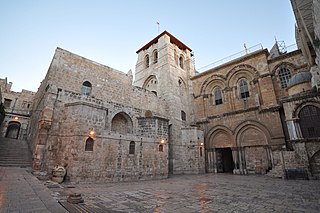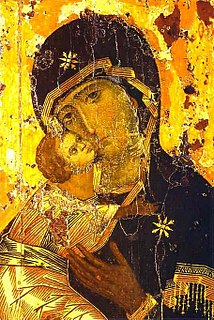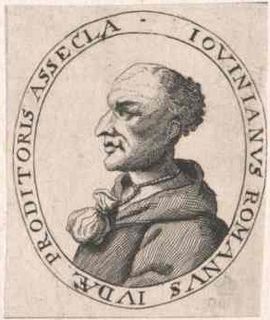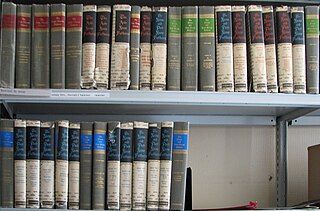Related Research Articles

Arianism is a Christological doctrine first attributed to Arius, a Christian presbyter from Alexandria, Egypt. Arian theology holds that Jesus Christ is the Son of God, who was begotten by God the Father with the difference that the Son of God did not always exist but was begotten within time by God the Father, therefore Jesus was not co-eternal with God the Father.

Ambrose of Milan, venerated as Saint Ambrose, was a theologian and statesman who served as Bishop of Milan from 374 to 397. He expressed himself prominently as a public figure, fiercely promoting the Christian faith against Arianism and paganism. He left a substantial collection of writings, of which the best known include the ethical commentary De officiis ministrorum (377–391), and the exegetical Exameron (386–390). His preachings, his actions and his literary works, in addition to his innovative musical hymnography, made him one of the most influential ecclesiastical figures of the 4th century.

Christianity is an Abrahamic monotheistic religion based on the life and teachings of Jesus of Nazareth. It is the world's largest religion, with about 2.8 billion followers, representing one-third of the global population. Its adherents, known as Christians, are estimated to make up a majority of the population in 157 countries and territories, and believe that Jesus is the Son of God, whose coming as the messiah was prophesied in the Hebrew Bible and chronicled in the New Testament.

Doctor of the Church, also referred to as Doctor of the Universal Church, is a title given by the Catholic Church to saints recognized as having made a significant contribution to theology or doctrine through their research, study, or writing.

Constantinian shift is used by some theologians and historians of antiquity to describe the political and theological changes that took place during the 4th-century under the leadership of Emperor Constantine the Great. Rodney Clapp claims that the shift or change started in the year 200. The term was popularized by the Mennonite theologian John H. Yoder. He claims that the change was not just freedom from persecution but an alliance between the State and the Church that led to a kind of Caesaropapism. The claim that there ever was a Constantinian shift has been disputed; Peter Leithart argues that there was a "brief, ambiguous 'Constantinian moment' in the fourth century", but that there was "no permanent, epochal 'Constantinian shift'".

The perpetual virginity of Mary is a Christian doctrine that Mary, the mother of Jesus, was a virgin before, during and after the birth of Christ. In Western Christianity, the Catholic Church adheres to the doctrine, as do some Lutherans, Anglicans, Reformed, and other Protestants. Shenouda III, Pope of the Coptic Orthodox Church, affirmed the teaching, and Eastern Orthodox churches recognize Mary as Aeiparthenos, meaning "ever-virgin". It is one of the four Marian dogmas of the Catholic Church. Most modern nonconformist Protestants reject the doctrine.

Jovinian was an opponent of Christian asceticism in the 4th century and was condemned as a heretic at synods convened in Rome under Pope Siricius and in Milan by Ambrose in 393, because of his anti-ascetic views. Our information about him is derived principally from the work of Jerome in two books, Adversus Jovinianum. Jerome referred to him as the "Epicurus of Christianity". He was a native of Corduene, in present day Turkey. John Henry Newman called Aerius of Sebaste, Jovinian and Vigilantius the forerunners of Protestantism, likening them to the "Luther, Calvin, and Zwingli of the fourth century". Other Protestants also praise Jovinian as an early reformer or even credit him as the "first Protestant". Jovinian's teachings received much popular support in Rome and Milan and his followers, Sarmatio and Barbatianus kept preaching his ideas after Jovinian was expelled.

Patristics or patrology is the study of the early Christian writers who are designated Church Fathers. The names derive from the combined forms of Latin pater and Greek patḗr (father). The period is generally considered to run from the end of New Testament times or end of the Apostolic Age to either AD 451 or to the Second Council of Nicaea in 787.
Vigilantius the Christian presbyter, wrote a work, no longer extant, which opposed a number of common 5th-century practices, and which inspired one of the most violent of the polemical treatises of Jerome. Vigilantius was born about 370 at Calagurris in Aquitania, where his father kept an inn on the great Roman road from Gallia Aquitania to Spain. While still a youth his talent became known to Sulpicius Severus, who had estates in that neighborhood, and in 395 Sulpicius, who probably baptized him, sent him with letters to Paulinus of Nola, where he met with a friendly reception. Some Protestant historians regard Vigilantius, along with Jovinian, Aerius of Sebaste and Helvidius, as 4th-5th century early proto-protestants.
Against Jovinianus is a two-volume treatise by the Church Father Saint Jerome.

Jovinianism refers to an anti-ascetic movement that has its origins in the 4th-century theologian Jovinian, who criticized the monastic movement and argued for the equality of marriage and celibacy. Jovinianism was criticized by Saint Augustine and Jerome.
Helvidius was the author of a work written prior to 383 against the belief in the perpetual virginity of Mary. Helvidius maintained that the biblical mention of "sisters" and "brothers" of the Lord constitutes solid evidence that Mary had normal marital relations with Joseph and additional children after the miraculous conception and birth of Jesus. He supported his opinion by the writings of Tertullian and Victorinus. Helvidius is sometimes seen as an early proto-protestant, along with Vigiliantius, Jovinian and Aerius of Sebaste.
Aerius of Pontus was a 4th-century presbyter of Sebaste in Pontus. He taught doctrines that were in opposition to 4th-5th century Christian beliefs. His views are known from St Epiphanius's Panarion in which he was accused of being an Arian. For a short period, he had many followers in Sebaste. He failed to make his teachings widely popular and his sect died out soon after his death. Aerius of Sebaste is sometimes seen as an early proto-protestant, along with Jovinian, Helvidius and Vigiliantius.

The Catholic Church and the Eastern Orthodox Church have been in a state of official schism from one another, with a few short-lived reunifications since the East–West Schism of 1054. That original schism was exacerbated by historical and language differences, and the ensuing theological differences between the Western and Eastern churches.

Christianity in late antiquity traces Christianity during the Christian Roman Empire – the period from the rise of Christianity under Emperor Constantine, until the fall of the Western Roman Empire. The end-date of this period varies because the transition to the sub-Roman period occurred gradually and at different times in different areas. One may generally date late ancient Christianity as lasting to the late 6th century and the re-conquests under Justinian of the Byzantine Empire, though a more traditional end-date is 476, the year in which Odoacer deposed Romulus Augustus, traditionally considered the last western emperor.

The state church of the Roman Empire refers to the church approved by the Roman emperors after Theodosius I issued the Edict of Thessalonica in 380, which recognized the catholic orthodoxy of Nicene Christians in the Great Church as the Roman Empire's state religion. Most historians refer to the Nicene church associated with emperors in a variety of ways: as the catholic church, the orthodox church, the imperial church, the imperial Roman church, or the Byzantine church although some of those terms are also used for wider communions extending outside the Roman Empire. The Eastern Orthodox Church, Oriental Orthodoxy, and the Catholic Church all claim to stand in continuity from the Nicene church to which Theodosius granted recognition, but do not consider it to be a creation of the Roman Empire.
The history of Eastern Orthodox Christian theology begins with the life of Jesus and the forming of the Christian Church. Major events include the Chalcedonian schism of 451 with the Oriental Orthodox miaphysites, the Iconoclast controversy of the 8th and 9th centuries, the Photian schism (863-867), the Great Schism between East and West, and the Hesychast controversy. The period after the end of the Second World War in 1945 saw a re-engagement with the Greek, and more recently Syriac Fathers that included a rediscovery of the theological works of St. Gregory Palamas, which has resulted in a renewal of Orthodox theology in the 20th and 21st centuries.

The Church Fathers, Early Church Fathers, Christian Fathers, or Fathers of the Church were ancient and influential Christian theologians and writers who established the intellectual and doctrinal foundations of Christianity. The historical period in which they worked became known as the Patristic Era and spans approximately from the late 1st to mid-8th centuries, flourishing in particular during the 4th and 5th centuries, when Christianity was in the process of establishing itself as the state church of the Roman Empire.

Proto-Protestantism, also called pre-Protestantism, refers to individuals and movements that propagated ideas similar to Protestantism before 1517, which historians usually regard as the starting year for the Reformation era. The relationship between medieval sects and Protestantism is an issue that has been debated by historians.
Barbatinus was a 4th-century early Church theologian and a Jovinianist. Barbatianus disputed the merit of the unmarried life and opposed ascetism. Barbatianus along with Sarmatio met Jovinian when he travelled to Milan and found themselves to have similar ideas. Ambrose wrote a letter Barbatianus tried to influence the episcopal election at Vercelli
References
- ↑ Butler, Clement Moore (1868). An Ecclesiastical History, from the First to the Thirteenth Century. M'Calla & Stavely.
- 1 2 Greenslade, Stanley Lawrence (1956-01-01). Early Latin Theology: Selections from Tertullian, Cyprian, Ambrose, and Jerome. Westminster John Knox Press. ISBN 978-0-664-24154-4.
- ↑ Kurtz, Professor (2020-07-27). Church History: Volume 1. BoD – Books on Demand. ISBN 978-3-7523-4770-8.
- ↑ "Philip Schaff: History of the Christian Church, Volume III: Nicene and Post-Nicene Christianity. A.D. 311-600 - Christian Classics Ethereal Library". www.ccel.org. Retrieved 2022-06-18.
- ↑ Hunter, David G. (2007-01-26). Marriage, Celibacy, and Heresy in Ancient Christianity: The Jovinianist Controversy. OUP Oxford. ISBN 978-0-19-153553-6.
- ↑ The Catholic University of America Studies in Sacred Theology. Catholic University of America Press. 1956.
- ↑ "CHURCH FATHERS: Letter 63 (Ambrose)". www.newadvent.org. Retrieved 2022-06-18.